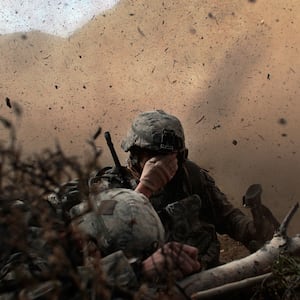JERUSALEM–Two decades of expanding operations against what United States Special Operations Command called a “global insurgency of state and non-state actors” has led to fatigue at home and questions abroad about U.S. strategy.
The latest Trump administration deal with the Taliban, challenges to the U.S. role in Syria and Iraq, and a potential reduction of forces in Africa point to a global trend in how the U.S. will deal with counter-insurgency in the future.
What we’re looking at is a global drawdown in U.S. forces committed to counter-terrorist operations at the same time President Donald Trump is demanding other countries, including NATO allies, do more. The idea is for the U.S. to focus on using technology, such as drones, while local forces do the fighting on the ground.
This long-term shift has long-term consequences that mean countries such as Iran, China and Russia, which the U.S. sees as adversaries, will have a larger footprint in places where the U.S. is reducing its role. Outsourcing counter-terrorism to these countries may not have been the plan, but it is likely one outcome.
U.S. Secretary of State Mike Pompeo began a tour of Africa on Feb. 16 in Senegal where the Flintlock 2020 exercise is underway with neighboring Mauritania. Some 1,600 soldiers from 30 African states and western allies are participating in the annual drill from February 17-28.
The U.S. says it is the year’s “premier special operations” exercise that strengthens security across a swath of countries through what’s called the Trans-Sahara Counter-Terrorism Partnership. The concept, pushed in 2018 via an act of Congress, was to improve the capabilities of countries to fight terror.
But the picture is bleaker than past U.S. statements have indicated. Funding to the tune of hundreds of millions of dollars to fight terror spread across Niger, Mauritania, Mali, Nigeria and a dozen states from Senegal to Somalia hasn’t reduced terror and has resulted in Washington’s decision to reconsider what comes next. The U.S. pulled forces out of Libya in 2019 and three Americans were killed in an attack on a base in Kenya by Somalia’s Al-Shabab in January.
Although Pompeo says that “we’ll get it right” in terms of U.S. commitment to a swath of African states, reports indicate the U.S. is reducing the footprint on the ground. Washington has “downgraded” efforts against extremists, the New York Times reported in mid-February.
France, which sent hundreds more troops to the Sahel region recently, has warned this is a bad idea. The overall numbers could mean cutting in half the U.S. presence of 5,000 troops in a dozen locations.
Changes in Africa strategy are only the tip of the iceberg of a much larger policy shift.
On the one hand the U.S. National Defense Strategy wants to move away from counter-insurgency to competing against large states like Iran, China and Russia. The Pentagon believes that “inter-state strategic competition, not terrorism, is now the primary concern in US national security.”
Since U.S. Special Operations Command (SOCOM) expanded from 47,000 in 2007 to 80,000 today, it might be argued that the U.S. has reached peak strength in fighting terror and now can move on successfully. The problem is that from Afghanistan to the Philippines to Niger there has not been a major success.
In Afghanistan, where the U.S. has been fighting the Taliban for almost 20 years, some sort of peace deal is in the works. President Donald Trump has sought to end such “endless wars,” and Democrats running to replace him also want to end this one.
In Iraq and Syria the U.S. appears to be reducing its role as well. Trump twice announced a withdrawal from Syria only to relent and keep troops to protect “oil” while slowly walking away from America’s anti-ISIS partners in the Syrian Democratic Forces.
Plans to use bases in neighboring Iraq to “watch Iran” have not panned out and the U.S. finds itself pressured to leave most of Iraq after tensions with Iran boiled over in January following U.S. decision to blow away near Baghdad airport Iran’s Quds Force commander Qassem Soleimani and Iraqi militia leader Abu Mahdi al-Muhandis.
Meanwhile, rocket fire has targeted U.S. bases and forces near the U.S. embassy almost every week since October 2019.
The long-term result in Afghanistan, Syria, Iraq, and across Africa can be seen symbolically in what is already happening in the Philippines.
For two decades Washington and Manila worked closely against extremist groups. Now Philippine President Rodrigo Duterte wants to scrap the Visiting Forces Agreement amid increasingly friendly relations with China.
For a more isolationist-inclined American public that may not matter, but it does mean China and other countries will aid the Philippines in the fight against Islamist insurgents. That has implications across Asia and the Pacific.
In Africa, Russian President Vladimir Putin has set his eyes on a larger role that includes priority access to vital mineral resources. He held a summit in October with African diplomats. Russia’s Wagner group and other contractors play an increasing role in Sudan, the Central African Republic, Libya and Mozambique.
In each place where the U.S. seeks a smaller footprint there will be a competition to fill the vacuum.
France will try to fill it in Chad, Mali, Mauritania, Niger, and Burkina Faso, the G5 countries it works with in the Sahel. But in many cases there won’t be NATO powers that share U.S. values doing the heavy lifting. Instead it will be Russia, Iran, China, Turkey, and even Saudi Arabia or India playing a bigger role.
That means counter-insurgency that looks more like Riyadh’s campaign in Yemen, Russia’s in Syria and Chechnya, China’s in Xinjiang, Turkey’s in Afrin, or India’s in Kashmir.
While that may fit the bill of a Trump administration that wants to spend less American treasure abroad and wants others to do more of the work, in the long term it means a fundamental change in the international role of the United States.
It also means that in an attempt to shift resources to confronting major states, the U.S. will provide a vacuum for some of those states—China, Russia and Iran—to play a greater role in Africa, the Middle East, and Asia.








